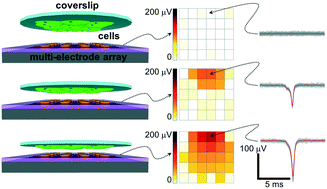Non-contact monitoring of extra-cellular field potentials with a multi-electrode array†
Abstract
Developing tools to enable non-invasive, high-throughput electrophysiology measurements of large functional-networks of electrogenic cells used as in vitro disease models for the heart and brain remains an outstanding challenge for preclinical drug discovery, where failures are costly and can prove to be fatal during clinical trials. Here we demonstrate, for the first time, that it is possible to perform non-contact monitoring of extra-cellular field potentials with a multi-electrode array (MEA). To do this preliminary demonstration we built a prototype with a custom mechanical stage to micro-position cells grown on conventional glass coverslips over the recording surface of a MEA sensor. The prototype can monitor extra-cellular fields generated by multi-cellular networks in a non-contact configuration, enabling a single MEA sensor to probe different cultures in succession, without fouling or degrading its sensitive electronic surface. This first demonstration with easy to culture cardiomyocyte cells and a prototype device points to the exciting possibility for instrument development leading to more efficient and cost-effective drug screening paradigms for cardiovascular and neurological diseases.



 Please wait while we load your content...
Please wait while we load your content...
